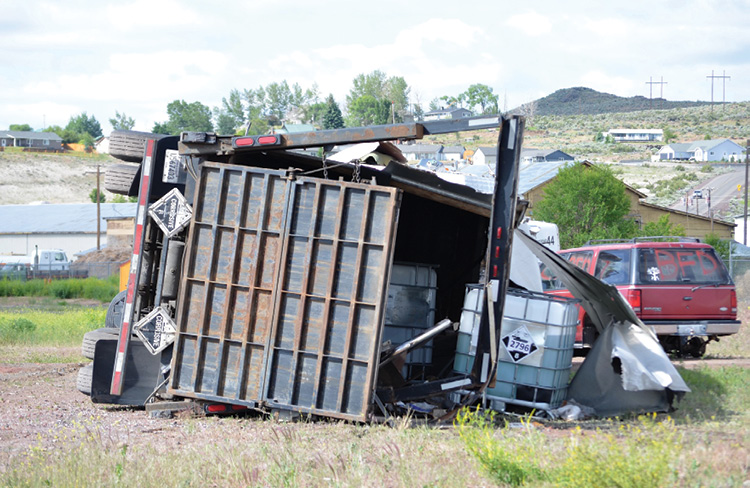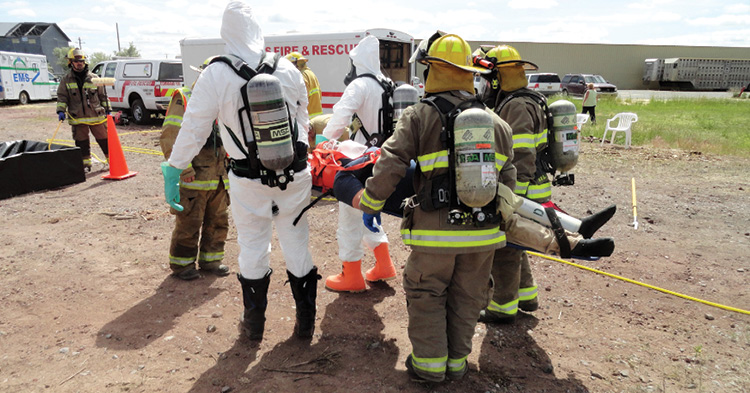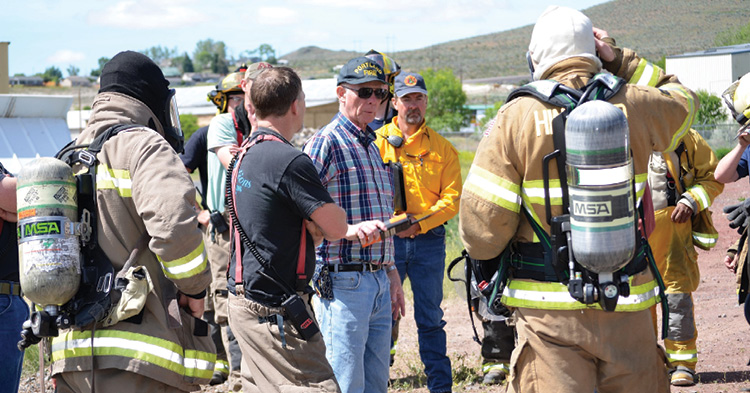
By STEPHEN L. HERMANN and WILLIAM A. HENLE
To judge their capability of effectively responding to a hazardous materials emergency, many jurisdictions and departments run a training exercise, usually a “full-scale exercise” (FSE). As defined by the Federal Emergency Management Agency (FEMA), “FSEs are typically the most complex and resource-intensive type of exercise. They involve multiple agencies, organizations, and jurisdictions … FSEs often include many players operating under cooperative systems such as the Incident Command System or Unified Command.”

(1) This full-scale exercise (FSE) for the Burns, Hines, and Burns Piute Tribe fire departments involved a simulated sulfuric battery acid spill. The objectives included addressing areas for improvement from a previous FSE after-action report/improvement plan. (Photos courtesy of Steven L. Hermann.)
Many departments receive funding grants of federal dollars from either the U.S. Department of Homeland Security (DHS) or the U.S. Department of Transportation, typically administered at the state level by the Office of the State Fire Marshal, the Office of Emergency Management, or a similar state agency. To receive these federal dollars, agencies must sign a grant agreement that states they will comply with the DHS’s Homeland Security Exercise and Evaluation Program (HSEEP), which is the source of the exercise definition noted above.

(2) This FSE involved an acid contaminated victim and focused on the actions taken by first responders prior to arrival of the hazardous materials team.
HSEEP contains several extensive bureaucratic requirements involving written exercise plans or situation manuals; master scenario event lists (MSELs); exercise evaluation guides; initial, midterm, and final planning meetings; controller/evaluator handbooks; and other administrative documents and procedures. For many departments, it sometimes seems that the “administrative tail is wagging the exercise dog,” and you can sometimes forget why they are doing all of this paperwork and scurrying around.
As first responders, we [the authors] have responded to hundreds of chemical spills and clandestine drug laboratories and participated in or conducted scores of exercises, from tabletop discussions to FSEs involving railroad chlorine tank cars and multiple local, county, state, and federal agencies. Recently, we planned and conducted an FSE in Oregon for the Burns, Hines, and Burns Piute Tribe fire departments involving a simulated sulfuric battery acid spill. The exercise included an acid-contaminated victim and focused on the actions taken by first responders prior to arrival of the hazardous materials response team.
We used a different technique than usual for this exercise; several times, we simply stopped the event, gathered the participants, and discussed the scenario and exercise actions taken up to that point. We then talked about how the incident action plan (IAP) provided the next logical steps and resumed the real-time exercise play. The purpose was to achieve the maximum training value for all participants involved.
The problem with most exercises is that most of the players are usually at some distance from the critical operations being executed at that moment, and most have a poor mental picture of what is going on. We wanted to counteract this all-too-common problem while still maintaining the purpose of the overall exercise and “real-world” exercise play and timeline involving actual resources, full equipment, and so on.
The purpose of an exercise is to better prepare participants for a similar event in the “real world” involving a chemical spill. So, it seems only logical that any steps we take to have all of the players fully participate—rather than act as distant onlookers—will better serve the attendees and their departments. Our experience with this Oregon exercise verified that not only is this possible but also it results in greater attendee appreciation of the entire process as well as better learning and training.
For every exercise we have conducted, we employed the format of a Participant Feedback Form (Table 1) recommended in a template by FEMA, with minor modifications. The overall tabulated rating scores for this exercise from the participants were the highest we have ever seen. Table 1 shows the form questions involving a numerical rating of 1-5 and notes on our recent scoring experience from this exercise.

The HSEEP document states: “A well-designed exercise provides a low-risk environment to test capabilities, familiarize personnel with roles and responsibilities, and foster meaningful interaction and communication across organizations.” Our experience with the new “stop-and-go” exercise format indicates that we can maximize all the positive aspects of this statement while avoiding the following two major factors that detract from many exercises:
- The participants are frequently too far away to understand what is happening.
- The exercise administrators are so busy keeping things on schedule following the various exercise documents and ensuring written evaluations are being accomplished that they completely lose track of the actual “training value” for the participants.

(3) A new FSE technique was used, stopping the action several times when events strayed from the ideal or there appeared to be confusion. All participants were brought together for a brief discussion; then exercise play was resumed. This procedure produced a much better understanding of the key events among all participants.
One can’t help but be reminded of an old comic strip quote, “We have met the enemy, and it is us.” The very mechanics of conducting, participating in, evaluating, and administering an FSE keep us from “seeing the forest for the trees.”
Exercise Objectives
Most FSEs feature several other factors that keep the exercise from being a fully productive learning experience for everyone. However, let’s examine the formal objectives as determined by the exercise planning team for this recent “stop-and-go” exercise. These goals represent smaller jurisdictions and simulate hazardous materials spills. (For this exercise, there may have been too many objectives for the scheduled half-day event, but the planning team felt comfortable with the exercise given how well the participating agencies had performed in a previous FSE several years prior.) The objectives include the following:
- Lifesaving and responder safety are always the highest priorities and the first objective.
- Address areas for improvement identified in the 2014 Harney County Full-Scale Exercise After Action Report.
- There was some initial confusion over hot-, warm-, and cold-zone boundaries and the location of the line establishing the cold-zone perimeter.
- We did not observe any specific discussion of possible evacuations downwind.
- We did not recognize the need for the air support trailer for long-duration operations.
- We did not observe any detection instrument readings reported to incident command.
- In most incidents, the local fire agency will initially respond, assume initial IC responsibilities, and request activation/deployment of the hazmat team.
- Based on the incident size, the type of chemical/substance, and the weather projections, establish a safe zone and determine a location for onsite staging and decontamination. Reevaluate as the situation changes.
- Assess the type, severity, and size of the incident. If possible, characterize the hazardous materials of concern and determine appropriate personal protection equipment requirements.
- Develop a recurring IAP. The Planning Section develops this document and the IC approves it. Discuss the IAP at regular intervals, and modify it as the situation changes.
- Establish a victim decontamination treatment area.
- Coordinate resource access, deployment, and storage in the operational area.
- Manage and coordinate interagency functions. Providing multiagency coordination is the primary goal. Assimilate into a unified command structure as dictated by incident.
Although the exercise participants had received the briefing required by HSEEP prior to the exercise, this was a large list of expectations from most fire departments. Add to this the fact that actual hazardous materials emergency spills are fairly infrequent across the country, and you begin to get the slight “glazed eyes” mindset common to many FSE participants; for many, they may be thinking, “Oh Lord, don’t let me mess this up.”

(4) In most FSEs, most of the participants are usually some distance from critical operations and have a poor picture of what is happening. By periodically pausing and bringing everyone together in a calm atmosphere to discuss key events, we emphasized important teaching points.

(5) Based on this FSE, this “stop-and-go” technique is a better way to ensure all exercise participants obtain the maximum training value rather than be uninformed and uninvolved observers some distance from the actual events.
Like any complex mechanism with a lot of moving parts, this list of expected achievements also weighs heavily on the exercise administrators and evaluators, who must make everything work without the bottom falling out; they have only so much time to do it before they have to be back inside for the exercise “hot wash” and conclusion. They also must make sure no one gets hurt; nothing gets too badly damaged, broken, lost, or misplaced; and it all appears coherent. And, they have to finish their paperwork and turn it in before they leave the exercise.
Unless the controllers and evaluators are experienced, this whole event comes close to being overwhelming; unfortunately, “solid participant training value” usually takes a back seat to administrative timelines and requirements. If it is your job, it’s only human to do your best to “keep the train moving down the track” and the exercise on schedule, addressing all of the objectives, MSEL events, and injections that keep the scenario moving. Almost everyone gets wrapped up in following all the rules, “dotting the I’s and crossing the T’s,” staying on schedule to finish on time, and not getting anyone hurt or anything lost.
As soon as one or two events in the initial stages have strayed from the ideal, some unexpected confusion has occurred, or key participants are unaware of what they are supposed to do or why, it is time for a pause. Sometimes, you must gather participants into the scene from as far as a quarter-mile away, since staging protocols and “initial isolation distances” can run for hundreds of yards. But since the whole idea is “maximum training value,” perhaps you should concentrate on what really counts: Make sure everyone is properly brought into the scenario and understands the pros and cons of the actions up to this point.
If experienced controllers concentrate on just two or three key points and do not allow for any digressions or loss of focus, you can briefly pause the action for five to 10 minutes. The goal is to make sure everyone understands what has transpired, what the scene really looks like, and what the actual hazards are. Make sure that no one has any questions about what you just talked about, and then send everyone back to their places.
There were a few key events during this training that everyone should experience and understand. The controllers can simply explain that they are administratively and temporarily shrinking the usual isolation distances for training clarity and then continue with the scenario. Once the critical events conclude, you can return personnel to their appropriate distances, depending on the scenario and determinations that may have been reached about decreasing the initial isolation distance.
In our recent “stop-and-go” exercise, you could literally see the comprehension increasing; every participant understood the situation completely regarding which actions worked and which did not. After several other short pauses in the action for review and instruction, we concluded the exercise successfully. The participants returned to a fire station classroom for the “hot wash” and to fill out their participant feedback forms. These reviews not only enhanced the training but also helped us to evaluate plans, procedures, and tactics more quickly.
One problem with most FSEs is that there is so much activity going on in such a short time that when the exercise ends, most participants feel that many of the events and potential learning opportunities have become a “blur” in their minds. The “stop-and-go” approach corrects this problem because it emphasizes major teaching points and discusses better problem resolutions. Breaking up the scenario into several shorter blocks, with learning reinforcement conducted in a calmer atmosphere, is a positive aspect of this new approach.
The advantages of this periodic review exercise process also include the following:
- Talking about what just happened and discussing alternate tactics.
- Quickly correcting misunderstandings to enhance exercise efficiency.
- Determining if departmental procedures and guidelines are being followed.
- Providing solid input for changing procedures or plans.
Based on the experience of this recent exercise in Oregon, we are convinced that this “stop-and-go” technique is a better way to ensure all exercise participants obtain the maximum training value rather than just “moving the train down the track” and staying on schedule.
STEVE L. HERMANN, CEM, retired as the hazardous materials coordinator for the Arizona Department of Public Safety. He also served as Arizona’s senior state-on-scene coordinator for hazardous materials emergency response. He has supervised more than 120 serious hazardous materials highway and rail incidents over the past 35 years; has participated in raiding more than 150 clandestine drug laboratories; and has published more than 130 articles for police, fire, and environmental magazines. Hermann is a senior executive fellow at Harvard University’s John F. Kennedy School of Government. He is a retired Army Chemical Corps Colonel in the United States Army Reserves and is a graduate of the United States Army Command and General Staff College and the U.S. Army War College. Hermann has a bachelor of science degree in explosives technology from the University of Minnesota and is a graduate of the U.S. Naval School Explosive Ordnance Disposal.
WILLIAM A. HENLE has more than 36 years of experience teaching hazardous materials and responding to hazardous materials incidents. He recently retired as the hazardous materials coordinator for Portland (OR) Fire and Rescue. Henle is certified as a hazardous materials instructor. He has a B.A. in education from Parsons College. Henle has responded to more than 500 hazardous materials incidents including more than 300 clandestine drug labs and was responsible for all hazardous materials response operations and training for the 700-member fire department, where he was also the team leader for the Hazmat Response Team. He was the chair of the State Hazmat Teams Advisory Group and served four years as lead instructor in the Fire Science Technology program at Portland Community College.

